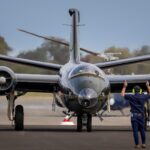By James Kightly, Commissioning Editor
On April 12th, 2024 adventurer Michael Smith set off to recreate the first aerial circumnavigation of Australia by seaplane, starting exactly 100 years after two Royal Australian Air Force (RAAF) aircrew lifted off from Port Philip Bay to achieve the goal. Smith will follow the same route as former acting Chief of the Air Staff Wing Commander SJ ‘Jimmy’ Goble and pilot Flying Officer Ivor McIntyre used in 1924 for their flight which took 44 days.

Although Smith’s his twin engine Chaika LLC L65 Seabear seaplane Southern Sun could complete the task in a third of the time, the adventurer wants to remain faithful to the original journey by also spending 44 days making the flight and following Australia’s coastline in an anti-clockwise direction. As well as proving in 1924 that an aircraft could fly around Australia, the original flight delivered the first aerial survey of Australia’s coastline.

Starting from RAAF Base Point Cook near Melbourne, Smith is hoping the weather conditions will be more favorable than those encountered by the initial pioneers in their single-engine Fairey IIID seaplane. In 1924 the RAAF airmen managed to complete 93 flying hours with compass failure on the maiden flight, poor maps, experiencing strong winds and heavy rain, surviving terrible turbulence that caused damage to their aircraft, and suffering fatigue with Goble reporting afterwards that the flight was “extremely tiring” and something he “would not like to face again”.
For their efforts Goble and McIntyre were appointed Commanders of the Order of the British Empire (CBE), and the flight and the achievement were recognized by the award of the Britannia Trophy for 1924. When asked why he was taking on this feat, Smith responded like a true adventurer: “Because it’s fun and I’m looking forward to seeing the beaches at 500 feet.”
More seriously, he added: “It’s so important to recognize the mechanized apparatus that made Australian life possible. Still today there are towns where their mail and milk are delivered by plane. It’s also a chance to reflect on the services of our air force and the importance of airbases today. We must preserve these airfields, built where they are, because of the information gathered from that flight 100 years ago,” Smith said.

He is joined on the event by other pilots who will circumnavigate Australia in the opposite direction, avoiding the cooler and more unpredictable weather patterns. Mr Smith, who has been flying for 20 years, was named the Australian Geographic Adventurer of the Year in 2016 after becoming the first person to solo circumnavigate the globe in his previous aircraft, a single-engine amphibian.

Wing Commander Rob Gill, Commanding Officer of 21 Squadron RAAF and Senior Australian Defence Force Officer at RAAF Base Point Cook, presented Smith with an RAAF ensign to carry with him on his journey. “We’re proud to present Smith with this symbol of the Royal Australian Air Force to accompany him on his journey and look forward to welcoming him on his safe return next month,” said Gill.

The RAAF are recognizing this anniversary as well with Exercise Centenarie Redimus. Two Boeing EA-18G Growlers of 6 Sqn RAAF were dispatched from RAAF Base Amberley, Queensland on April 11th to start their 2024 rendition of the circumnavigation. The intent of the exercise, in addition to the commemoration, was to demonstrate an ability to operate from a variety of airfields across Australia, and provide an opportunity to engage the Australian public while promoting a career working with EA-18 Growlers and Air Combat Group. A highlight of Exercise Centenarie Redimus was Flight Training School and Air Mission Training School students being offered one of four incentive flights. This flight also recognized the 50th anniversary of a 6 Sqn F-111 flight, crewed by Wing Commander Ray Funnell and Squadron Leader John Miller, which completed the same feat in 1974.
Follow Smith as he retraces this historic journey at http://southernsun.voyage/aroundoz100



























